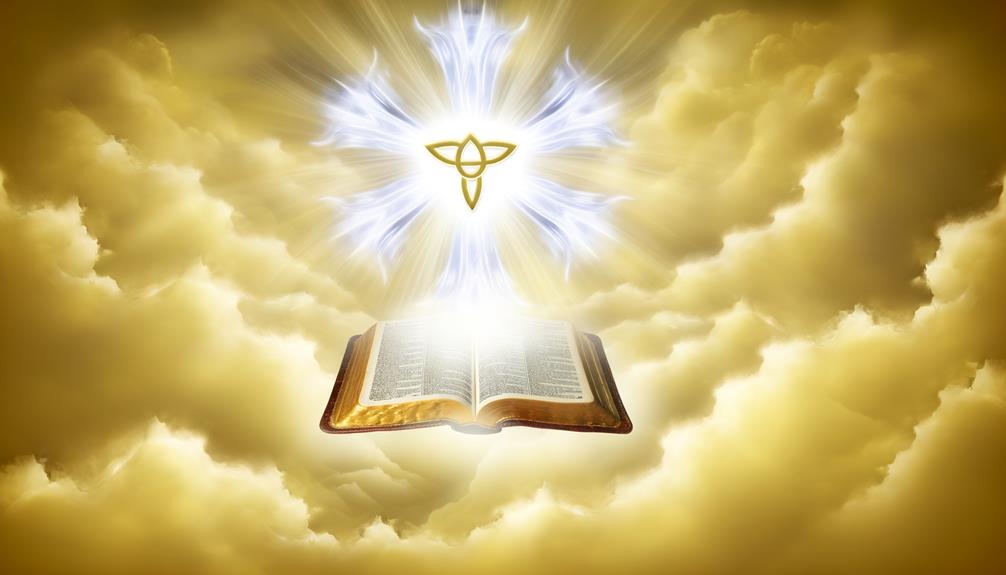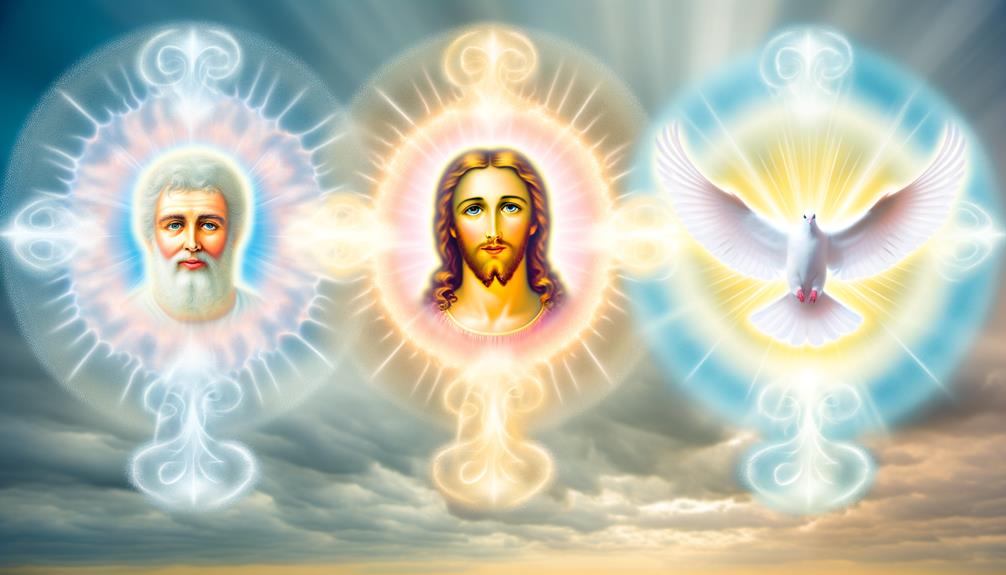Godhead Meaning In The Bible: Divine Nature
The term ‘Godhead‘ in the Bible represents the concept of the Trinity, where the Father, the Son (Jesus Christ), and the Holy Spirit are distinct persons united in one divine essence. In the Old Covenant, the term ‘Elohim’ suggests a complex unity, while prophetic texts hint at divine plurality.
New Testament passages, such as John 1:1-14 and Matthew 28:19, further elucidate this triune relationship. This intrinsic unity and co-equality among the divine persons form the basis of Christian Trinitarian doctrine.
For a more thorough understanding, exploring these scriptures in conjunction with historical and theological interpretations is essential.

Godhead Meaning in the Bible: Understanding Divine Nature and Trinity
| Aspect | Biblical Interpretation |
|---|---|
| Literal Meaning | The divine nature or essence of God |
| Key Scriptures | Acts 17:29, Romans 1:20, Colossians 2:9 |
| Symbolism | Fullness of deity, unity of Father, Son, and Holy Spirit |
| Doctrinal Significance | Foundation for the Christian belief in the Trinity |
| Spiritual Insight | Emphasizes God’s eternal power, divinity, and invisible attributes |
| Theological Implication | God’s complete presence and authority manifested in Jesus Christ |
Biblical References to Godhead

The term ‘Godhead‘ in the Bible is primarily found in three key passages, each contributing to a deeper theological understanding of the divine nature.
In Romans 1:20, the term underscores God’s eternal power and divine nature, reflecting His invisible attributes through creation.
Colossians 2:9 emphasizes the fullness of the Godhead dwelling bodily in Christ, encapsulating the totality of divine essence within Jesus.
Finally, Acts 17:29 speaks to the divine nature transcending material representations, cautioning against idolatry.
Together, these passages delineate a multifaceted view of the Godhead, encompassing God’s omnipotence, the incarnate deity of Christ, and the transcendence of divine nature beyond physical form, thereby offering a thorough biblical perspective on the concept.
Old Testament Insights

The Old Covenant provides foundational insights into the concept of the Godhead through its portrayal of divine nature, the use of the term Elohim, and prophetic references.
The plurality inherent in the term Elohim hints at a complex unity within the Godhead, which is further illuminated by ancient prophetic texts.
These elements collectively contribute to a nuanced understanding of the divine nature as expressed in the Hebrew Scriptures.
Divine Nature Revealed
Ancient Hebrew scriptures provide profound insights into the divine nature through various depictions and narratives, revealing multifaceted aspects of God’s character and essence.
These texts emphasize God’s:
- Omnipotence: Demonstrated in the creation narrative where God speaks the universe into existence (Genesis 1:1-3).
- Omniscience: Highlighted by His knowledge of human thoughts and actions before they happen (Psalm 139:1-4).
- Holiness: Encapsulated in His moral perfection and separation from sin (Isaiah 6:3).
- Covenant Faithfulness: Illustrated in His enduring promises to the patriarchs Abraham, Isaac, and Jacob (Genesis 17:7).
These characteristics collectively form a rich tapestry that underscores the complexity and depth of the divine nature as revealed in the Old Scriptures.
Elohim and Plurality
Among the multifaceted revelations of God’s nature, the term ‘Elohim‘ in the Old Scripture introduces intriguing insights into the concept of plurality within the divine essence.
‘Elohim,’ though grammatically plural, often refers singularly to the one God of Israel, suggesting a complex unity. This plurality is not indicative of polytheism but rather a composite unity within the Godhead.
Instances such as Genesis 1:26, where God says, ‘Let us make man in our image,’ further emphasize this. Scholars argue that this plural form hints at the triune nature later revealed in Christian doctrine, offering a nuanced understanding of divine complexity.
Consequently, ‘Elohim’ enriches the theological discourse on the nature of God’s singularity and plurality.
Ancient Prophetic References
Prophetic passages in the Old Scriptures provide profound insights into the multifaceted nature of the Godhead, often foreshadowing the complex unity later elucidated in Christian theology. Key texts reveal the anticipatory themes of divine plurality and unity:
- Isaiah 9:6 – The prophecy of a child called ‘Mighty God’ and ‘Everlasting Father,’ hinting at divine incarnation.
- Psalm 110:1 – David’s Lord speaking to his Lord, suggesting distinct persons within the Godhead.
- Isaiah 48:16 – Reference to the Spirit and the Lord God, indicating a complex divine interrelation.
- Daniel 7:13-14 – The vision of the ‘Son of Man’ receiving eternal dominion, illustrating a divine figure distinct yet unified with God.
These passages collectively enrich the foundational understanding of the Godhead.
New Testament Explanations

In the New Covenant, the concept of the Godhead is elucidated through various passages that emphasize the unity and distinctiveness of the Father, Son, and Holy Spirit. Key New Scripture passages provide a foundational understanding of this theological construct. John 1:1-14 introduces the divinity of Christ, while Matthew 28:19 mandates baptism in the name of the Father, Son, and Holy Spirit, underscoring their coequality. Additionally, 2 Corinthians 13:14 speaks of the grace of Jesus, the love of God, and the fellowship of the Holy Spirit, highlighting their relational unity.
| Verse | Aspect Highlighted | Significance |
|---|---|---|
| John 1:1-14 | Divinity of Christ | Christ’s divine nature |
| Matthew 28:19 | Trinitarian Baptism | Coequality in the Godhead |
| 2 Corinthians 13:14 | Relational Unity | Grace, love, fellowship |
The Trinity in Christian Doctrine

The concept of the Trinity, foundational to Christian doctrine, encapsulates the unity of Father, Son, and Holy Spirit as three distinct persons within one Godhead.
This theological construct is deeply rooted in biblical exegesis, drawing from scriptural passages that emphasize both the distinctiveness and unity of the divine persons.
Examining the Trinity’s theological significance reveals its pivotal role in shaping core Christian beliefs and practices, underscoring the complexity and depth of the Christian understanding of God.
Biblical Trinity Foundations
Although the term ‘Trinity’ does not explicitly appear in the Bible, the foundational concepts of the Father, the Son, and the Holy Spirit are deeply embedded within Christian doctrine. Scriptural passages collectively underscore the triune nature of God.
- Creation: Genesis 1:26 states, ‘Let Us make man in Our image,’ indicating a plurality in the divine.
- Baptism of Jesus: Matthew 3:16-17 presents the Father, the Son, and the Holy Spirit in a unified act.
- Great Commission: In Matthew 28:19, Jesus commands, ‘baptizing them in the name of the Father, and of the Son, and of the Holy Spirit.’
- Pauline Epistles: 2 Corinthians 13:14 speaks of ‘the grace of the Lord Jesus Christ, the love of God, and the fellowship of the Holy Spirit.’
These elements substantiate the doctrine’s biblical roots.
Trinity’s Theological Significance
Understanding the theological significance of the Trinity requires an exploration of its foundational role in defining the nature of God and the relationship between the Father, the Son, and the Holy Spirit within Christian doctrine.
The Trinity encapsulates the co-equal, co-eternal nature of the three distinct persons who are one in fundamental nature and being. This doctrine underscores the unity and diversity within God’s singular nature, offering profound insights into how Christians perceive divine interaction and salvation history.
The relational dynamics within the Trinity serve as a model for human relationships, emphasizing love, cooperation, and unity.
Theologically, the Trinity affirms the incarnation of Christ and the indwelling of the Holy Spirit, integral to understanding God’s ongoing presence and activity in the world.
Attributes of the Godhead

One of the key attributes of the Godhead in biblical theology is omniscience, encompassing complete and infinite knowledge. This attribute is foundational to understanding the divine nature.
The Godhead is also characterized by:
- Omnipotence: Possessing unlimited power, able to accomplish anything that is within the domain of divine will.
- Omnipresence: Existing everywhere at all times, transcending spatial limitations.
- Immutability: Unchanging over time, remaining constant in nature and character.
- Holiness: Absolute moral purity and separation from sin, embodying perfect righteousness.
These attributes collectively illustrate the Godhead’s transcendence and immanence, providing a framework for theological reflection and worship. Each quality underscores the distinct and unparalleled nature of the divine as portrayed in biblical texts.
Historical Interpretations

Throughout history, theologians and scholars have offered diverse interpretations of the Godhead as depicted in the Bible, reflecting evolving doctrinal and philosophical perspectives.
Early Christian thinkers like Augustine emphasized the unity and co-equality of the Trinity, while the Council of Nicaea (325 AD) affirmed the consubstantiality of the Father, Son, and Holy Spirit.
Medieval scholastics, such as Thomas Aquinas, further explored the relational dynamics within the Godhead using Aristotelian philosophy.
The Reformation era introduced significant debates, with figures like John Calvin underscoring the sovereignty and distinct personhood within the Godhead.
These historical interpretations have profoundly influenced Christian theology, demonstrating a dynamic interplay between scriptural exegesis and philosophical inquiry in understanding the divine nature.
Godhead in Different Denominations

Across various Christian denominations, the conceptualization of the Godhead reveals significant theological divergences, reflecting distinct doctrinal emphases and interpretative traditions. These differences manifest in several ways:
- Trinitarian Doctrine: Most mainstream denominations, such as Roman Catholicism and Protestantism, uphold the Trinity, defining the Godhead as three co-equal persons: Father, Son, and Holy Spirit.
- Unitarianism: This perspective, held by groups like Unitarians, rejects the Trinity, viewing God as a single entity.
- Modalism: Some Pentecostal denominations endorse Modalism, teaching that God manifests in different modes or aspects rather than distinct persons.
- Eastern Orthodoxy: This tradition emphasizes the mystery of the Trinity, articulating the Godhead’s unity and distinctiveness through apophatic theology.
These doctrinal distinctions underscore the rich, yet complex, landscape of Christian theological thought on the Godhead.
Theological Implications

Examining the theological implications of the Godhead reveals profound insights into the nature of divine interaction, worship practices, and doctrinal development within Christianity.
The concept of the Godhead, often understood as the Trinity, fundamentally shapes Christian theology by elucidating the relationships between the Father, Son, and Holy Spirit. These relationships influence worship practices and theological formulations.
| Aspect | Implication |
|---|---|
| Divine Interaction | Reveals relational dynamics |
| Worship Practices | Shapes liturgical expressions |
| Doctrinal Development | Informs theological constructs |
Conclusion
The exploration of the concept of the Godhead, as seen through biblical references, Old and New Scriptures insights, and the doctrine of the Trinity, reveals a multifaceted theological construct.
Attributes of the Godhead, along with historical and denominational interpretations, add layers of complexity.
Such an in-depth analysis illuminates the profound theological implications, like a tapestry woven with threads of divine mystery and doctrinal clarity, underscoring the enduring significance of the Godhead in Christian thought.






